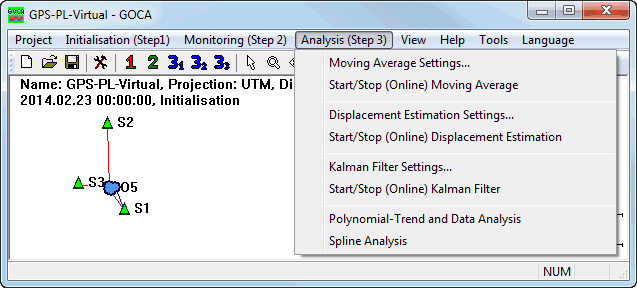
GOCA-Deformationanalysis-Software
The GOCA-Deformationanalysis-Software is responsable for the evaluation and analysis of the sensor-data.
Creation and administration of GOCA-Projects (point- and epoch-manager, user-defined coordinate-systems).
Determination of the coordinates of a stable >reference-frame and their administration.
Verification of the stability of reference-points.
Continuous determination of object-point-time-series in the reference-datum.
Continuous determination of sensor values (1D geotechnical sensors).
Online estimation of moving average.
Online estimation of displacements with test-statistic.
Online estimation of position, velocity and acceleration for each sensor based on a Kalman-Filter..
Visualisisation of sensor-/object-point-time-series in a comfortable and flexible graphik-window.
Postprocessing-filters, as polynom- and spline-estimations.
Detailed graphical software documentation.

GOCA-Project-Management
An online monitoring with the GOCA-System requires the creation of a project.
This includes the specification of a project-name, the specification of the unsed sensors and the devision in reference-points and object-points.
If needed, a local coordinate-system (e.g. the building-system) can be defined too.
The project-specific data is stored in a project save-file and several system-files for each project.
For the determination of the coordinates of the reference-points as well as for checking their stability, an epoch-manager is available.
The actual project-configuration can be saved and opened anytime or even automatically. With the automatic observation of all current online-processes, a GOCA-project can be reactivated automatically (e.g. after power blackout). Because of the open interfaces for observation ans solution data, interval- and post-processing is also possible.

GOCA-Project-Initialisation
The project-initialisation is responsible the determination of a stable reference-datum, in which the positions of the object-points have to be estimated from the beginning of collecting time-series-data.
All observations of an initial epoch, which has to be defined with the epoch manager, are introduced in this least-squares-estimation.
The adjustment is carried out separately for plan- and height-component, three-dimensional or one-dimensional for seperate sensors.
In both first cases all observations are transformed or reduced to a common coordinate-reference-system with consideration of the law of error-propagation.
In this first adjustment the stable reference-points are introduced only once als unknowns, whereas the points in the object-area can be introduced multiple times if neccessary.
The initialisation includes the automated statistical testing and elimination of bad observation-data.
The observations which were detected to be bad, can be marked in the raw-data-files and excluded from further computations.
The results of the adjustment are summarized in output-protocol-files.
With the point-coordinates resulting from the adjustment, the transformation-parameters for the transformation in a predefined user-system can be determined.
Continuous Determination of Sensor-Values and Object-Point-Coordinates and Graphic-Windows
In each monitoring-epoch (maximum is the tracking-interval), the sensor values and object-point-coordinates are determined in the reference-datum by means of least-squares or robust L1 adjustment. The result ist stored in daily files and can be visualized and analyzed.

The graphic-window displays the time-series-data of a selected sensor-/object-point starting at any epoch up to the current data set. For regarding details, several zoom-functions and the possibility to display the most current data is provided. The settings for the graphic-window allow to enable or disable any coordinate-component of the sensor-/object-point-time-series, as well as of estimated filter-time-series.
Smoothing, Filtering and Analysis of Sensor- and Object-Point-Time-Series
As filter-functions in the online-mode, moving average and displacement estimations are provided. The determination can be done as a least-squares or as a robust L1-norm-estimation. The filtered data are stored continuously in daily-files and are displayed together with the sensor-/object-point-time-series.
In the postprocessing-mode, the filtering is done for a selected epoch and the reuslt is also displayed in the graphic window. Here also polynomials and spline functions is provided.
Critical Deformations can be detected with the displacement estimation filter.
With two preprocessed and adjusted epochs, a deformation analysis with statistical test is calculated between these two epochs to get significant solutions of object-point movements.
(figures below: moving average, polynomial of 5th order, displacement estimation)



Kalman-Filter - Continuous Determination of Position, Velocity and Acceleration
The GOCA-Kalman-Filter-module allows a continuous determination of position, velocity and acceleration for each object-point. The resulting time-series can be displayed for each component in a graphic-window (figure below). At present a powerful alarm-standard based on this Kalman-Filter-module is developed in the frame of the GOCA-research-project.


